|
|
 |
Fiche d'espèce de Copépode |
|
|
Calanoida ( Ordre ) |
|
|
|
Arietelloidea ( Superfamille ) |
|
|
|
Nullosetigeridae ( Famille ) |
|
|
|
Nullosetigera ( Genre ) |
|
|
| |
Nullosetigera helgae (Farran, 1908) (F,M) | |
| | | | | | | Syn.: | Phyllopus bidentatus : I.C. Thompson, 1903 (Descr. M); Wolfenden, 1904 (P5 M); Farran, 1905 (part., p.45, figs.M, fig.21: F); Van Breemen, 1908 (P5 M);
Phyllopus helgae Farran, 1908 b (p.83, figs.F); A. Scott, 1909 (p.148, figs.F,M); Wolfenden, 1911 (p.328, figs.F,M); Sars, 1925 (p.342, figs.F,M); Farran, 1926 (p.290); Rose, 1933 a (p.246, figs.F,M); Hardy & Gunther, 1935 (1936) (p.183, Rem.: ?); Tanaka, 1937 (p.270, figs.M); Jespersen, 1940 (p.66); Wilson, 1942 a (p.202, fig.F); Lysholm & al., 1945 (p.41); Brodsky, 1950 (1967) (p.401, figs.F,M, Rem.) ; C.B. Wilson, 1950 (p.288); Fagetti, 1962 (p.32); Grice & Hart, 1962 (p.287, table 3, p.293: Rem.); Grice, 1963 a (p.496); Tanaka, 1964 c (p.240, figs.F,M); De Decker & Mombeck, 1964 (p.13); Vervoort, 1965 (p.156, Rem.); Grice & Hulsemann, 1965 (p.225); Furuhashi, 1966 a (p.295, vertical distribution in Kuroshio region, Table 9); Owre & Foyo, 1967 (p.91, figs.F,M); Grice & Hulsemann, 1967 (p.19); Vinogradov, 1968 (1970) (p.79); Bradford, 1970 a (p.361, figs.F); Park, 1970 (p.478); Roe, 1972 (p.277, tabl.1, tabl.2); 1972 c (p.1036); Bainbridge, 1972 (p.61, Appendix Table III: occurrence); Vives & al., 1975 (p.52, tab.II, IV, XII); Deevey & Brooks, 1977 (p.156, tab.2, Station "S"); Carter, 1977 (1978) (p.36); Pipe & Coombs, 1980 (p.223, vertical occurrence); Stephen & Rao, 1980 (p.239, tab.1, 2, fig.2); Björnberg & al., 1981 (p.654, figs.F,M); Chahsavar & Razouls, 1982 (p.32, fig.F); Roe, 1984 (p.359); Guangshan & Honglin, 1984 (p.118, tab.); Brenning, 1985 a (p.28, Table 2); 1986 (p.14, Rem.); Madhupratap & Haridas, 1986 (p.105, tab.1); Lozano Soldevilla & al., 1988 (p.60); Heinrich, 1990 (p.19); Hattori, 1991 (tab.1, Appendix); Shih & Young, 1995 (p.67); Chihara & Murano, 1997 (p.862, Pl.143,144: F,M); Bradford-Grieve & al., 1999 (p.884, 950, figs.F,M); Bradford-Grieve,1999 b (p.127, figs.F,M, Rem., figs.180, 192); d'Elbée, 2001(tabl.1); Hsiao & al., 2004 (p.326, tab.1); Hwang & al., 2007 (p.23) | | | | Ref.: | | | Soh & al., 1999 (p.1583, fig.12: chart, phylogenetic relationships); Boxshall & Halsey, 2004 (p.150); Vives & Shmeleva, 2007 (p.389, figs.F,M, Rem.) | 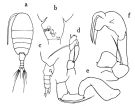 issued from : O. Tanaka in Publs Seto Mar. Biol. Lab., 1964, XII (3). [p.240, Fig.225]. As Phyllopus helgae. Female: a, habitus (dorsal); b, genital somite (ventral); c, last thoracic segment and urosome (right lateral side); d, P5. Nota: Cephalothorax 1.64 mm; abdomen 0.73 mm. Abdominal segments and caudal rami in the proportional lengths 40 : 14 : 14 : 18 : 14 = 100. Genital segment asymmetrical, the right lateral margin is much produced; genital area furnished with 2 irregular lamellous plates; the distal ventral margin of the segment has a triangular process on the left side. Caudal rami 1.5 times as long as wide. A1 extends to the posterior margin of the 3rd thoracic segment. Male: e, right P5; f, left P5. Nota: Cephalothorax 1.52 mm; abdomen 0.77 mm. The last thoracic segment slightly asymmetrical; the lateral corner triangularly produced with a small process on the distal margin (in some specimens the lateral margin has 2 small processes). In P5: distal segment of the left leg elongated and curved. Right leg with a very small process on the inner proximal margin of the 3rd segment; the distal segment long and spoon-shaped.
|
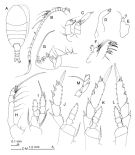 issued from : J.M. Bradford-Grieve in The Marine Fauna of New Zealand: Pelagic Calanoid Copepoda. National Institute of Water and Atmospheric Research (NIWA). NIWA Biodiversity Memoir, 111, 1999. [p.128, Fig.87]. As Phyllopus helgae. Female (30°45'S, 173°16'E): A, habitus (dorsal); B, A1; C, A2; D, mandibular blade; E, mandibular palp; F, Mx1; G, Mx2; H, Mxp; I, P1; J, P2; K, P3; L, P4; M, P5.
|
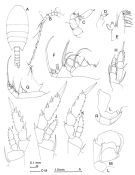 issued from : J.M. Bradford-Grieve in The Marine Fauna of New Zealand: Pelagic Calanoid Copepoda. National Institute of Water and Atmospheric Research (NIWA). NIWA Biodiversity Memoir, 111, 1999. [p.129, Fig.88]. Male (from same locality than female): A, habitus (dorsal); B, left A1; C, A2; D, mandibular palp; E, Mx1; F, Mx2; G, Mxp; H, P1; I, P2; J, P3; K, P4; L, right P5; M, left P5. Female characteristics: Posterior borders of pediger segments 4+5 almost equal. - Genital segment quite large, asymmetrical with a swelling on the right. - Caudal rami divergent. - A1 much shorter than body. - P5 narrow with oblique articulations between exopod segments. Male characteristics: Caudal rami divergent. - P5 left endopod large and triangular. Nota: It seems that P. helgae also has an extension of the right male P5 exopod segment 2 although neither Farran (1905) nor Sars (1925) figures this character. Also the conspicuous constriction dividing the distal part of male left P5 exopod segment 2 from the rest of the limb is not figured by Farran (1905).
|
 issued from : J.M. Bradford in N.Z. Jl Mar. Freshw. Res., 1970, 4 (4). [p.360, Figs 70-72]. As Phyllopus helgae. Female (off Kaikoura, New Zealand): 70, habitus (dorsal); 71, genital segment (ventral); 72, P5. Scale bars represent 1.0 mm in 70 and 0.1 mm in 71-72.
|
 Issued from : G.O. Sars in Résult. Camp. Scient. Prince Albert I, 69, pls.1-127 (1924). [Pl.CXXIV, figs.1-6]. As Phyllopus helgae. Female: 1, habitus (dorsal); 2, P5; 3, genital segment, with spermatophore (ventral). Male: 4, habitus (dorsal); 5, left P5; 6, right P5.
|
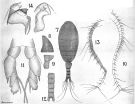 issued from : A. Scott in Siboga-Expedition, 1909, XIX a. [Plate XLVI, Figs.7-14]. As Phyllopus helgae. Female (from Celebes Sea): 7, habitus (dorsal); 8, forehead (lateral); 9, last thoracic and genital segments (left side); 10, A1; 11, P5. Male: 12, urosome (dorsal); 13, left A1; 14, P5.
|
 issued from : G.P. Farran in Ann. Rep. Fish. Brch., Ireland, 1902-1903, II, App. 2, 1905. [Plate XI, Fig. 16]. As Phyllopus bidentatus. Male (from W Ireland): 16, A1.
|
 issued from : G.P. Farran in Ann. Rep. Fish. Brch., Ireland, 1902-1903, II, App. 2, 1905. [Plate XI, Fig.21]. Female (from W Ireland): 21, P5.
|
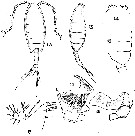 issued from : G.P. Farran in Ann. Rep. Fish. Brch., Ireland, 1902-1903, II, App. 2, 1905. [Plate XI, Figs.12-19]. As Phyllopus bidentatusMale (from W ireland): 12-13, habitus (dorsal and lateral, respectively); 14, rostrum (ventral); 15, last thoracic segments (lateal); 17, Mx1; 18, left P5; 19, right P5.
|
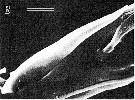 issued from : S. Ohtsuka & R. Huys in Hydrobiologia, 2001, 453/454. [p.448, Fig.4, B]. Male (from Japan): B, modified elements on geniculate A1 of compound segment. Scale bar = 0.01 mm.
|
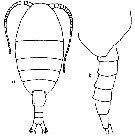 issued from : R.N. Wolfenden in Die Marinen Copepoden der Deutschen Südpolar-Expedition 1901-1903, 1911. [p.328, Fig.65]. Female: a, habitus (dorsal). Male: b, posterior part cephalothorax and urosome (lateral).
|
 issued from : H.Y. Soh, S. Ohtsuka, H. Imabayashi & H.-L. Suh, 1999, 33. [p.1594, Fig.8, C, D]; Female: C, genital double-somite (ventral); D, A1 (segment XXV and compound segment XXVI-XXVIII). Scale bar: 0.100 mm (C); 0.025 mm (D).
|
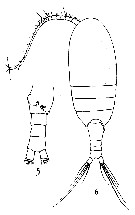 issued from : G.P. Farran in Fish. Ire. Sci. Invest., 1906, II [1908]. [Pl. IX, Figs.5-16]. As Phyllopus Helgae. Female (from W Ireland): 5, urosome (ventral); 6, habitus (dorsal).
|
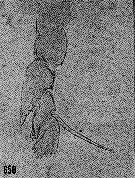 issued from : H.B. Owre & M. Foyo in Fauna Caribaea, 1, Crustacea, 1: Copepoda. Copepods of the Florida Current. 1967. [p.92, Fig.650]. As Phyllopus helgae. Female: 650, P5.
|
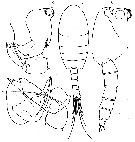 Issued from : O. Tanaka in Japanese J. Zool., 1937, VII, 13. [p.269, Fig.19]. As Phyllopus helgae. Male (from coast of Heda, Japan): a, habitus (dorsal); b, forehead (lateral); c, abdomen (lateral); d, right P5; e, left P5. Nota: Abdomen contained about 1.6 times in the length of the cephalothorax. The first three segments of the abdomen nearly equal in length and the last 2 segments also of equal length. Right A1 24-segmented. The last segment of the exopodite of the left P5 elongate and pointed at the apex and with a long curved spine on the outer distal half of the segment.
| | | | | Ref. compl.: | | | Lapernat, 2000 (tabl.3, 4); Holmes, 2001 (p.14); Galbraith, 2009 (pers. comm.); Williamson & McGowan, 2010 (p.273, Table 3, Pacific central gyres: N and S); M.L. Fernandez, 2013 (pers. comm.); Bonecker & a., 2014 (p.445, Table II: frequency, horizontal & vertical distributions) | | | | NZ: | 17 | | |
|
Carte de distribution de Nullosetigera helgae par zones géographiques
|
| | | | | | | | |  issued from : R. Stephen & T.S.S. Rao in J. Plankton Res., 1980, 2 (2). [p.245, Fig.2]. issued from : R. Stephen & T.S.S. Rao in J. Plankton Res., 1980, 2 (2). [p.245, Fig.2].
Distribution of Phyllopus (= Nullosetigera) in the Indian Ocean (open circles indicate the stations selected for the study). |
 issued from : H.Y. Soh, S. Ohtsuka, H. Imabayashi & H.-L. Suh in J. Nat. Hist., 1999, 33. [p.1599, Fig.12]. issued from : H.Y. Soh, S. Ohtsuka, H. Imabayashi & H.-L. Suh in J. Nat. Hist., 1999, 33. [p.1599, Fig.12].
Geographical distribution of Nullosetigera mutica (white triangle), Nullosetigera impar (black triangle), Nullosetigera bidentata (black circle) and Nullosetigera helgae (white square). |
| | | | Loc: | | | sub-Antarct. (? South Georgia), South Africa (E), off Tristan da Cunha Is., off Ghana, off Lagos, off E St. Paul Is., Cape Verde Is., S Brazil, off Rio de Janeiro, Senegal, off Mauritania-NW Cape Verde Is., off Morocco-Mauritania, Canary Is., Isla del Hierro, off Madeira, off W Cape Finisterre, Ibero-moroccan Bay, Bay of Biscay, Azores, G. of Mexico, Caribbean Sea, Florida, off Bermuda (Station "S"), Sargasso Sea, off S Newfoundland, W Iceland, Wyville Thomson Ridge, off W Ireland, Scotland, Natal, Somali, S Arabian Sea, Indian, Indonesia-Malaysia, Philippines, Viet-Nam (Cauda Bay), China Seas (East China Sea, South China Sea), Taiwan (S, E), Japan, Izu region, off Sanriku, Pacif. (N central), Pacific (central gyres: N and S), off British Columbia, Pacif. (SE tropical), Pacif. (W equatorial), New Zealand (NE South Island, off N North Island), Kermadec Is, Tasman Sea, off SE Easter Is., off Chile, off Valparaiso | | | | N: | 55 | | | | Lg.: | | | (1) F: 2,4; (5) F: 2,6; M: 2,45; (10) F: 2,25-2,15; (24) F: 2,4-2,3; M: 2,4; (38) F: 2,46-2,28; M: 2,46; (120) F: 2,37; M: 2,29; (128) M: 2,03; (199) F: 2,43-2,13; M: 2,43-2,13;(313) F: 2,4; (909) F: 2,23-2,9; M: 2,1-2,8; (1108) F: 2,43; M: 2,2-2,43; {F: 2,13-2,90; M: 2,03-2,80} | | | | Rem.: | épi-méso-bathypélagique. 480-510 m (Pipe & Coombs, 1980 at 60°N, 07°W). | | | Dernière mise à jour : 18/01/2021 | |
|
|
 Toute utilisation de ce site pour une publication sera mentionnée avec la référence suivante : Toute utilisation de ce site pour une publication sera mentionnée avec la référence suivante :
Razouls C., Desreumaux N., Kouwenberg J. et de Bovée F., 2005-2025. - Biodiversité des Copépodes planctoniques marins (morphologie, répartition géographique et données biologiques). Sorbonne Université, CNRS. Disponible sur http://copepodes.obs-banyuls.fr [Accédé le 04 décembre 2025] © copyright 2005-2025 Sorbonne Université, CNRS
|
|
 |
 |


















